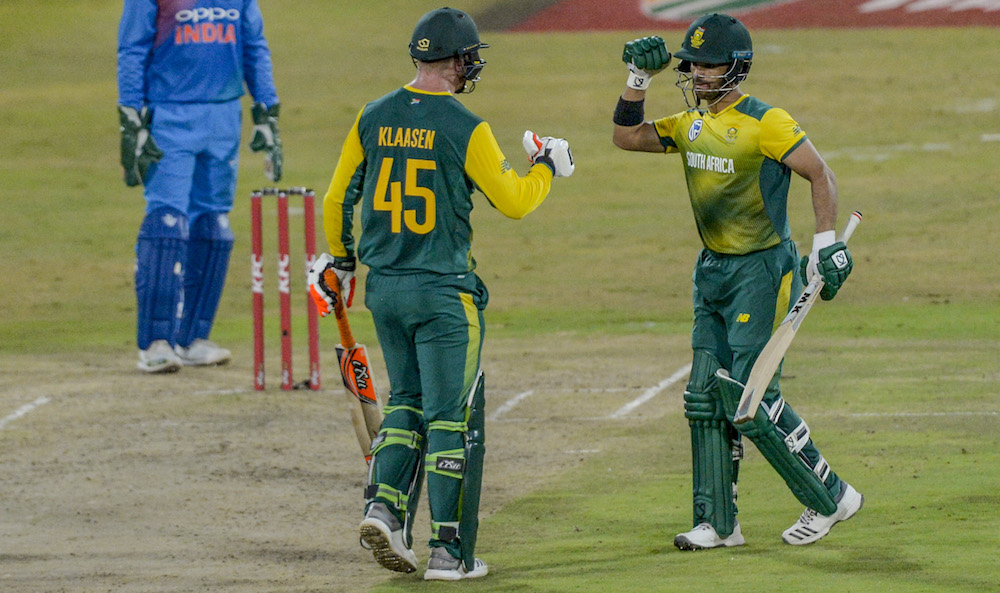It’s time for a reshuffle in the Proteas’ batting lineup, starting with the five-match ODI series in Sri Lanka, writes KHALID MOHIDIN.
The trying subcontinent conditions are the perfect test for any team. With the focus on World Cup success, the Proteas have selected a fresh squad for the five-match ODI series in Sri Lanka. Now is the time to build a team that not only carries the Proteas to the World Cup but also propels them beyond the tournament.
It starts with the Proteas’ top six.
When you factor in AB de Villiers’ retirement, and the ageing Hashim Amla, Faf du Plessis and JP Duminy, replacements have to be lined up before the tournament kicks off on 30 May 2019. Utilising this experienced core of players will be essential, but the best way to build a cohesive batting unit is to allow them to struggle together and to succeed together.
The Proteas’ opening partnership must lay the foundation for the rest of the team.
The Proteas have made it clear that they see a bright future for Aiden Markram. The 23-year-old has cemented his spot at the top of the Test batting order and is undoubtedly a natural opener. He has the ability to command an innings and dispel pressure by mimicking his partner’s intensity at the opposite end.
This was particularly evident in his innings in the One Day Cup final for the Titans in 2016-17. Despite Henry Davids leading the attack at the one end for his 114 off 98 balls, Markram supported and matched his partner until he surpassed him with an incredible 161 off 123 balls. This particular innings highlighted Markram’s ability to adapt his game according to the match’s flow, which will be vital for the Proteas in shifts between powerplays.
Moving Markram up the order with Quinton de Kock will ease the pressure on his left-handed partner and allow the wicketkeeper-batsman to play his natural game without the burden of being the main attacking force.
Having Markram opening allows Amla to move down to No 3. Despite his incredible record, Amla has struggled for form of late, and his age doesn’t work in his favour either – the 2019 World Cup is looking increasingly as if it might be his last contribution in national colours. This is the opposite for his opening partner De Kock, who still has a long career ahead of him.
Nevertheless, there is no denying that the bearded genius is one of the best ODI openers South Africa has ever produced. His natural timing and ability to exploit the gap has made him excellent at maintaining pressure on the opposition bowlers as well as manipulating the momentum of the game.
His experience only validates his strength of being able to read the game better than any other batsman in the top six, and this is why I envision him as the perfect candidate for the role of protector in the top order. It will also allow our future openers to build a partnership and develop that crucial element of chemistry between them.
At No 4 in the order, Reeza Hendricks has all the attributes needed to become the kingpin of an innings – technique, skill and attacking awareness. At 28, he is at the peak of his career and has consistently found himself in the top tier across all formats in domestic competitions for the Lions. His strike rate of 86.07 in 138 List A matches is impressive, as is his strike rate of 121.9 in his 89 T20s. His ability to switch his approach between formats expresses his control and understanding of his own game plan.
A performance that displayed all Hendricks’ attributes was his innings against India in the first T20I at the Wanderers. Opening the batting, he didn’t allow the format to deconstruct his natural game. He scored freely by playing risk-free shots as he racked up 10 fours for a 50-ball 70. The Proteas need someone who they can rely on from an attacking sense in the No 4 spot, especially after the exit of De Villiers. Hendricks is a player who can calm things down in the wake of a collapse, but he can also accelerate the run rate in a controlled manner. His style of play will perfectly complement anyone in the top six. The combination of Amla and Hendricks places the perfect barrier in front of the middle order.
A few beautiful shots by Reeza Hendricks early on including this one. The Proteas are 22/0 after 2 overs.
Now LIVE on SS2.#SAvSL pic.twitter.com/Biftglv2bm— SuperSport (@SuperSportTV) January 25, 2017
It is at No 6 where the decision becomes tricky. It is no secret that Duminy has lost favour with the Proteas fans. There is a widespread belief among the public that the 34-year-old is not deserving of his selection in the national side. Despite having all the talent, Duminy has been notoriously inconsistent. Stats provide the evidence: he has only scored one half-century in his last 22 matches, and has an average of 36.95 from 184 ODIs. However, it’s not his inconsistency that would make me drop him from the side… rather, it’s the more exciting ability of another player in the squad.
Step forward, Heinrich Klaasen.
Klaasen has the explosive power of a big-hitting No 6, yet he retains the technique of an elegant stroke-playing opener, and this makes him an invaluable asset for the Proteas. He had an incredible start to his ODI career where despite being part of the team that got smashed by India in the six-match series at home, he was the standout batsman in the series. At 26, he still has a long career ahead of him and his keeping ability makes him the ideal backup for De Kock, especially if the Proteas choose to temporarily relieve the left-hander from his wicketkeeping duties to allow him to focus on his batting. In his match-winning 43 off 27 balls against India in the pink ODI, Klaasen proved his attacking prowess. He showed no fear against India’s lethal spinning duo. This makes him a prized asset for a batting lineup that has time and again revealed its frailties against spin.
I believe this is the Proteas’ best batting lineup according to the current squad… and there is no better time to test this than on the turning wickets in Sri Lanka.
MY PROTEAS XI
1 Aiden Markram
2 Quinton de Kock
3 Hashim Amla
4 Reeza Hendricks
5 Faf du Plessis
6 Heinrich Klaasen
7 Andile Phehlukwayo/Wiaan Mulder
8 Kagiso Rabada
9 Keshav Maharaj
10 Lungi Ngidi/Junior Dala
11 Tabraiz Shamsi
Photo: Sydney Seshibedi/Gallo Images







